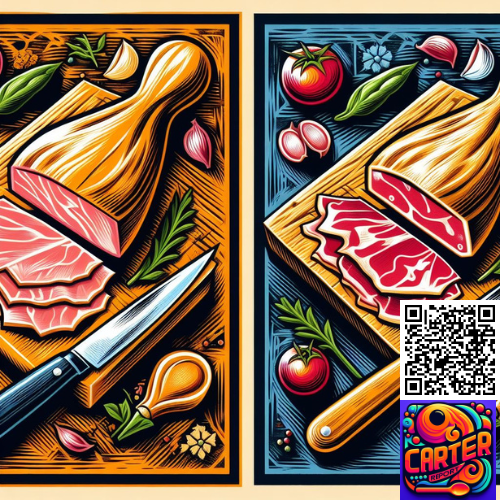In the gastronomic gladiator arena today, we have two heavyweights: pepperoni and salami. Both have graced charcuterie boards, snuck into sandwiches, and have been the unsung heroes of pizza toppings. But what really sets these two meaty contestants apart? Is it just a matter of spice, or is there a deeper, more flavorful tale to tell? Buckle up, food lovers, as we slice into this meaty matter with all the boldness, wit, and irreverence you can stomach.
Table of Contents
The Meat of the Matter
First off, both pepperoni and salami come from the great family of cured meats, born from the necessity to preserve all things delicious before refrigerators were a twinkle in electricity’s eye. But, like siblings vying for the last slice of cake, they have their differences.
Pepperoni: The Spicy American Dream
Pepperoni, with its bright red appearance and smoky undertone, is like that one friend who insists on adding hot sauce to everything. Originally an American creation, it’s the younger, spicier cousin in the salami family. Made from a blend of pork and beef, it’s seasoned with paprika or other chili pepper to give it that kick that wakes up your mouth (and sometimes, regretfully, your stomach).
Salami: The European Sophisticate
Salami, the elder statesman of the cured meat world, has European roots that run deep. Like a well-traveled uncle, it comes in many varieties, each telling a story of its origin, from Genoa to Soppressata. Primarily made from pork, it’s seasoned with garlic, herbs, and wine. The flavor is more nuanced, like a symphony compared to pepperoni’s rock concert.
Comparison Table
| Attribute | Pepperoni | Salami |
|---|---|---|
| Flavor | Spicy, smoky, and savory with a hint of paprika and garlic. | Rich, tangy, and slightly sweet with a complex blend of spices like black pepper, fennel, and garlic. |
| Texture | Firm and slightly chewy, with crispy edges when cooked. | Varies depending on the type, but often tender and moist with visible pieces of fat and spices. |
| Aroma | Strong and pungent, with notes of spices and cured meat. | Complex and aromatic, with hints of garlic, fennel, and other spices. |
| Color | Bright red or orange, often with specks of fat and spices. | Ranges from deep red to mahogany brown, with visible pieces of fat and spices. |
| Temperature | Usually served cold or at room temperature, but can be cooked on pizza or in pasta dishes. | Typically served cold or at room temperature, but can also be cooked in dishes like sandwiches or antipasto platters. |
| Mouthfeel | Satisfyingly meaty with a slight greasiness and a burst of flavor. | Tender and juicy, with a luxurious mouthfeel and a blend of savory and tangy flavors. |
From a food science perspective, the magic of both pepperoni and salami lies in the fermentation process. It’s here, in the battle between bacteria and meat, that these flavors are developed. The fermentation not only flavors but also preserves, making these meats shelf-stable through the power of lactic acid.
But why the difference in taste and texture? It all boils down to the specific blend of spices, the ratio of meats, and the curing time. Pepperoni is smoked after curing, adding that signature smoky undertone, while salami enjoys a slow cure, developing a complex bouquet of flavors.
(Personal Experience Interjection)
Once, in a daring culinary experiment, I attempted to substitute salami for pepperoni on a homemade pizza. The result? A delicious mess that left me appreciating the spicy kick and grease pools of pepperoni that complement the cheese so well. Lesson learned: sometimes, you just don’t mess with perfection.
The Nutritional Knockout
| Nutrient | Pepperoni (1 oz) | Salami (1 oz) |
|---|---|---|
| Calories | 130 | 110 |
| Total Fat | 11g | 9g |
| Sodium | 460mg | 420mg |
| Protein | 5g | 7g |
While neither is exactly a health food champion, salami slightly edges out with fewer calories and less fat. But remember, moderation is the key to enjoying these treats without turning your body into a cured meat museum.
Digging In To Some Questions…
Q1: Can I substitute pepperoni for salami in recipes?
- A1: Sure, if you’re feeling adventurous! Just remember, pepperoni will bring more heat and a smokier flavor to the party.
Q2: Which one is better for my health?
- A2: “Better” is relative when it comes to cured meats, but salami has a slight nutritional edge. Still, treat both as occasional indulgences rather than dietary staples.
Q3: Why does pepperoni curl on pizza?
- A3: Ah, the great curl conundrum! It’s all thanks to the high-fat content and cooking method. As it cooks, the edges curl up, creating those delightful little oil cups that pizza dreams are made of.
Q4: Is there a vegetarian alternative to both?
- A4: Absolutely! Several brands offer veggie-based versions of these classics, using things like tofu, seitan, and a whole spice cabinet to mimic the flavors.
Q5: How should I store them to extend their shelf life?
- A5: Keep them unopened in the refrigerator until the “use by” date. Once opened, wrap them tightly in plastic or wax paper, and use within a week for optimal freshness.
The Flavorful Finale
Whether you’re team pepperoni or salami, there’s no denying that these cured meats add a punch of flavor to any dish. Pepperoni may be the fiery, fun-loving sibling, ready to spice up your pizza night, while salami is the sophisticated, well-traveled type, perfect for elevating your charcuterie board game.
In the end, why choose? Life’s too short to limit your cured meat consumption. Mix and match, experiment, and find your perfect meaty match. Just remember, in the world of cured meats, variety isn’t just the spice of life—it’s the whole darn spice rack.










